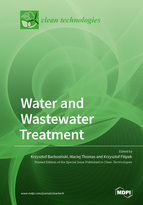Water and Wastewater Treatment
A special issue of Clean Technologies (ISSN 2571-8797).
Deadline for manuscript submissions: closed (20 December 2020) | Viewed by 29355
Special Issue Editors
Interests: water and wastewater technology; biological processes; advanced oxidation processes (AOPs); deammonification; nitrogen removal in a side stream; circular economy in a wastewater treatment plant; the recovery of raw materials from wastewater and sludge; the energy self-sufficiency of WWTPs; innovative technologies for the treatment of municipal and industrial wastewater; technologies and devices reducing the nuisance of WWTPs
Special Issues, Collections and Topics in MDPI journals
Interests: advanced oxidation processes (AOPs); the application of ferrate (VI) for the removal of organic compounds from water and wastewater; industrial wastewater treatment technology; novel environmentally friendly coagulants; the removal of heavy metal ions; general analytical chemistry; green chemistry
Special Issues, Collections and Topics in MDPI journals
Interests: water and wastewater treatment; sludge processing; wastewater re-usage; process engineering; risk analysis; formal and legal regulations of water and wastewater management
Special Issue Information
Dear colleagues,
Currently, there is a need for rapid progress and development in almost all industries and areas of human activity. For this reason, there is a strong need for the elaboration of numerous new technologies, as well as the development of existing innovative technologies. Such activities also include the field broadly considered as environmental engineering, in particular, problems related to water and wastewater treatment. Until recently, only “wasted water” was considered as wastewater, and the purpose of purification was to remove organic contaminants, as well as nitrogen and phosphorus, and additionally from industrial wastewater, specific impurities. Nowadays, wastewater is more often recognized as a source of energy and valuable resources. Such an approach is consistent with the assumptions of circular economy ideas that could be applied in wastewater treatment plants by means of energy production and its optimized consumption and the recovery of important raw materials, e.g., phosphorous, nitrogen, and water from wastewater and sludge. In the near future, it could also be possible to recover bioplastic materials (polyhydroxyalkanoates; PHAs) and to produce hydrogen (the fuel of the future). Therefore, nowadays, modern wastewater treatment plants should not be considered only as facilities protecting water ecosystems, but also as technological−energetic plants and objects for recovering important raw materials.
Moreover, there are some new challenges to be met by the wastewater treatment plants, e.g., the removal of pharmaceuticals. Currently, the purification processes carried out in wastewater treatment plants are not adapted to remove impurities such as, e.g., endocrine-disrupting compounds (EDCs) and pharmaceutical and personal care products (PPCPs). Therefore, in the nearest future, it is necessary to modernize the technological systems of treatment plants and to use more effective treatment techniques, such as advanced oxidation processes (AOPs), membrane processes, adsorption, etc.
It is also important to introduce the abovementioned advanced methods to facilitate effective treatment of industrial wastewater. The intensification of activities leading to the use of treated industrial wastewater for re-use as process water is particularly important.
Additionally, for this Special Issue of Clean Technologies, we are happy to welcome publications on the following topics:
- Application of environmentally friendly oxidizing agents, e.g., K2FeO4, to remove some specific impurities from industrial wastewater;
- Application of management tools to reduce environmental impact of wastewater treatment plants;
- Use of new solutions in the field of potable water treatment in order to remove micropollutants dangerous to human health.
Prof. Dr. Krzysztof Barbusiński
Dr. Maciej Thomas
Dr. Krzysztof Filipek
Guest Editors
Manuscript Submission Information
Manuscripts should be submitted online at www.mdpi.com by registering and logging in to this website. Once you are registered, click here to go to the submission form. Manuscripts can be submitted until the deadline. All submissions that pass pre-check are peer-reviewed. Accepted papers will be published continuously in the journal (as soon as accepted) and will be listed together on the special issue website. Research articles, review articles as well as short communications are invited. For planned papers, a title and short abstract (about 100 words) can be sent to the Editorial Office for announcement on this website.
Submitted manuscripts should not have been published previously, nor be under consideration for publication elsewhere (except conference proceedings papers). All manuscripts are thoroughly refereed through a single-blind peer-review process. A guide for authors and other relevant information for submission of manuscripts is available on the Instructions for Authors page. Clean Technologies is an international peer-reviewed open access quarterly journal published by MDPI.
Please visit the Instructions for Authors page before submitting a manuscript. Free publication for well-prepared manuscripts submitted before 31 December 2019. Submitted papers should be well formatted and use good English. Authors may use MDPI's English editing service prior to publication or during author revisions.
Keywords
- energy self-sufficiency of WWTP
- intensification of biogas production and use
- nitrogen removal in a side stream
- deammonification in the main stream
- recovery of raw materials from wastewater and sludge
- wastewater re-usage as process water
- removal of micropollutants from water and wastewater
- advanced oxidation processes








